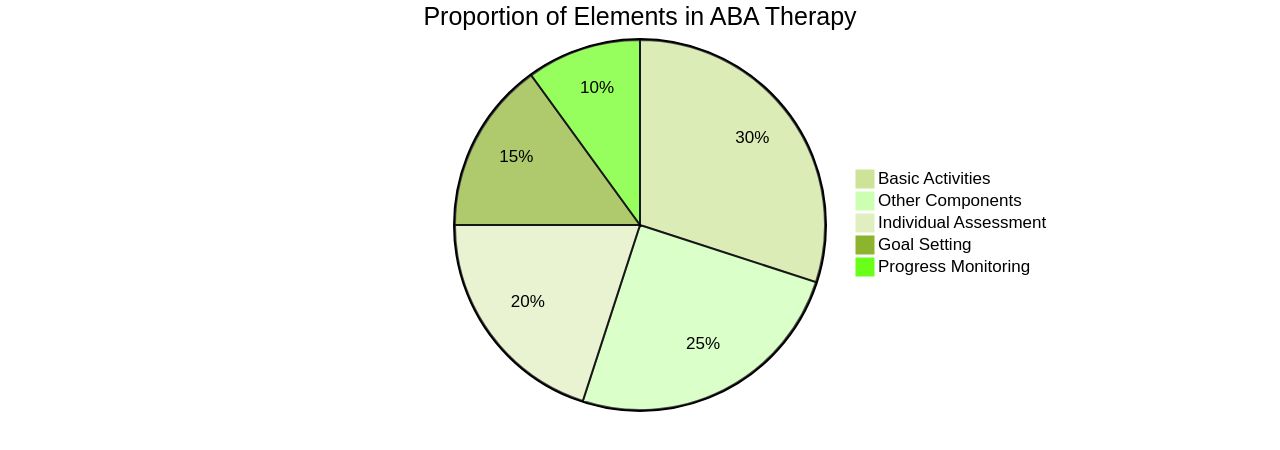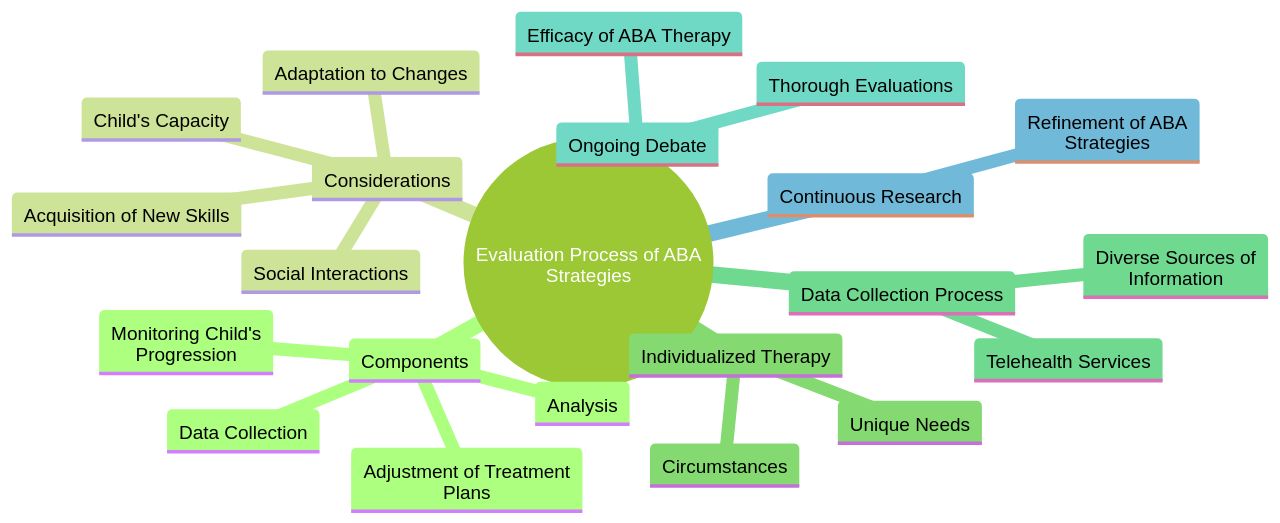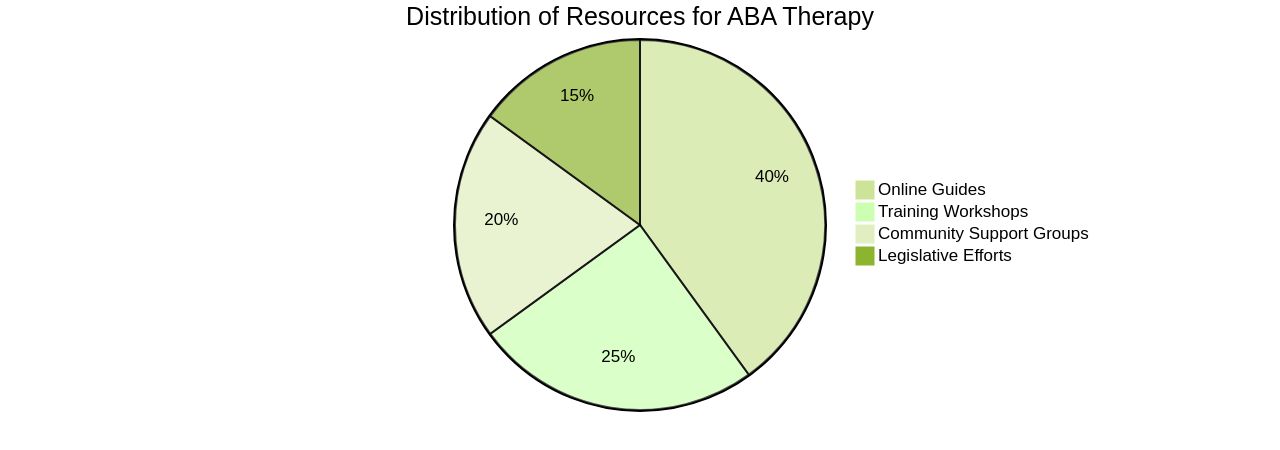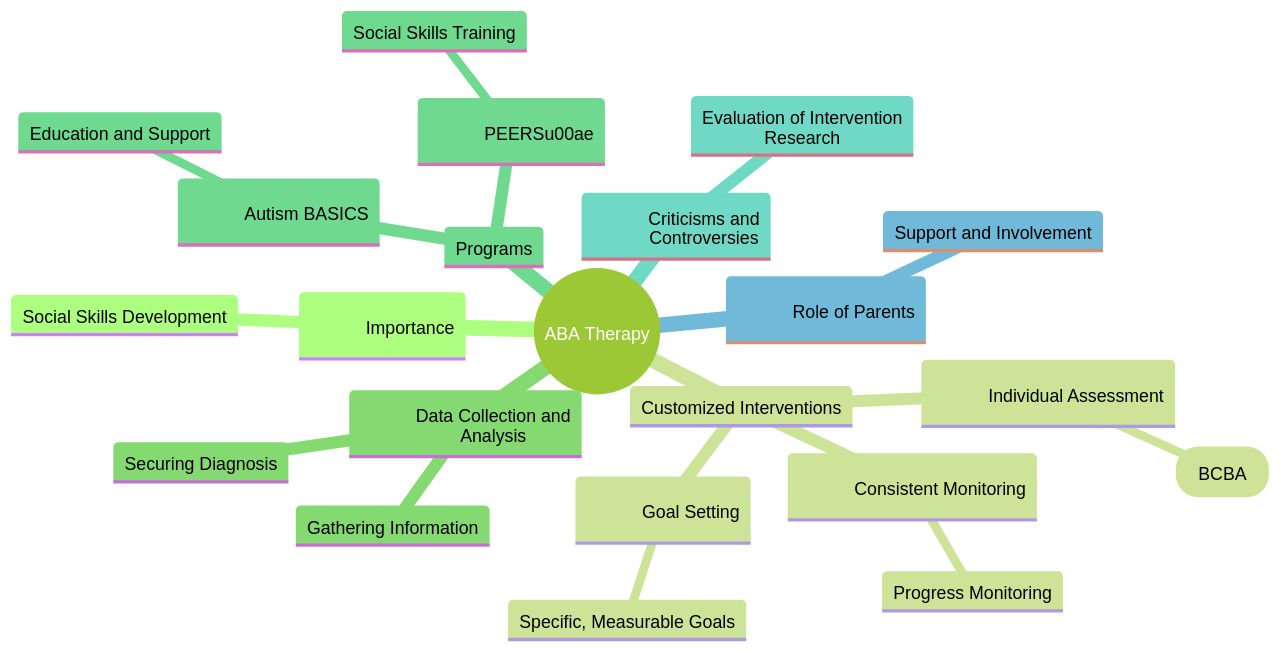Introduction
Applied Behavior Analysis (ABA) therapy is a recognized method aimed at fostering positive and significant behavioral changes, especially in children with autism. This therapy, also known as 'aba autism,' utilizes learning theory principles to enhance socially relevant behaviors.
It is an early intervention that involves spending up to 40 hours a week with an ABA-certified therapist, with the goal of acquiring beneficial skills and reducing behaviors that impede learning or daily life participation. However, while ABA therapy has its benefits, it's important to consider various factors that could lead to some undesirable effects. This article will explore the overview, techniques, effectiveness, and support services of ABA therapy, providing guidance and resources for Parent Advocates navigating the challenges of raising children with autism.
# 1. Overview of ABA Therapy for Autism
Applied Behavior Analysis (ABA) therapy is a recognized method aimed at fostering positive and significant behavioral changes, especially in children with autism. This therapy is grounded in learning theory's principles to enhance socially relevant behaviors. Often referred to as 'aba autism,' this approach is tailored to assist children in acquiring beneficial skills and reducing behaviors that might impede their learning or daily life participation.
ABA therapy is an early intervention that may require children to spend up to 40 hours a week with an ABA-certified therapist. The therapist guides children through basic activities, such as using the bathroom, getting dressed, or writing their name, rewarding them as they complete each task. As children master these basic skills, the duration spent in ABA therapy decreases, though many continue to receive it at home, in a clinic, or at school.
The effectiveness of an ABA program hinges on several key elements. Firstly, individual assessment is crucial as every child with autism is unique, and their program should reflect this. A thorough evaluation by a Board Certified Behavior Analyst (BCBA) is the initial step.
Based on this assessment, specific, measurable goals are set for the child. Progress is continuously monitored, and strategies are adjusted to ensure the child continues to benefit. The intake process involves gathering all the necessary information about the child and, if required, securing a diagnosis.
However, ABA does not adopt a 'one size fits all' approach, and it's essential to consider various factors that could lead to some undesirable effects. A recommendation of 30+ hours per week raises a series of concerns, including the financial impact on the family, coordination of care, and transition planning. Having a therapist at home for several hours each day can be seen as an invasion of privacy.
It also reduces the time for other social/community involvement, limits a parent's ability to work, and can strain parent-sibling and marital relationships. Children receiving ABA in clinics are affected by the time spent commuting, limited parental insight into their daily activities, and the potential lack of generalization of treatment gains to other environments. Hence, maintaining a therapy-life balance is vital for the child in treatment, their parents, and their siblings.
While ABA therapy has traditionally been backed by researchers, practitioners, and parents, some autism advocates have voiced concerns. They argue that ABA may punish autistic children for behaviors that aren't harmful to themselves or society. For example, many autistic children engage in 'stimming' behaviors, such as hand flapping or finger flicking, which help them manage anxiety or sensory overload.
ABA practitioners often aim to reduce or eliminate these behaviors. Critics argue that society should accommodate these behaviors rather than seek to eliminate them. Despite the professional consensus on certain crucial aspects of treatment such as intensity, family involvement, and focus on generalization, and empirical evidence for some intervention strategies, many programs developed for children with autism differ in philosophy.
Most programs are designed for preschool-age children, but not all are widely known or available. While outcome data are available for some of these programs, empirical studies comparing intervention programs are lacking. Therefore, it's imperative to commit to the scientific process and rigorous policy evaluation to determine whether and for whom the therapy works.

# 2. How ABA Therapy Works in Managing Autism
Applied Behavior Analysis (ABA) therapy operates under the principle of breaking down complex tasks into smaller, more manageable steps. This process involves teaching each step with the aid of prompts, which are gradually reduced as the child masters the task independently.
It's the cornerstone of ABA therapy to use positive reinforcement, encouraging children to repeat and maintain appropriate behaviors. The therapy is highly adaptable, allowing it to be tailored to each child's specific needs and learning style.
The central tenet of a successful ABA program lies in its foundational pillars. This begins with an individual assessment, recognizing that each child with autism is unique and requires a tailored program.
A Board Certified Behavior Analyst (BCBA) conducts a thorough evaluation as the initial step. Based on this evaluation, specific, measurable goals are set for the child.
Progress is consistently monitored, and strategies are regularly adjusted to ensure the child continues to reap benefits from the therapy. However, it's crucial to acknowledge that ABA therapy does not follow a 'one size fits all' approach.
Factors such as the financial impact on the family, coordination of care, and transition planning can pose challenges. Recommendations for extensive therapy hours, sometimes up to 30 hours per week, can lead to concerns regarding the therapy-life balance.
Having a therapist in the home for several hours each day can be perceived as an intrusion of privacy and can reduce time for other social or community involvement. It can also impact a parent's ability to work and may affect family relationships.
For children receiving ABA therapy in clinics, there are additional considerations, such as the time spent driving back and forth. This can limit parental insight into what their child does all day, and treatment gains might not generalize to other environments. Moreover, it's important to note that while ABA therapy is widely supported by practitioners and parents, not all children who receive it endorse its use. Some studies suggest long-term gains in functioning, but these are often of middling scientific quality, casting doubt on the therapy's status as an authoritative treatment. It's plausible that ABA therapy is helpful in some cases and potentially harmful in others. Therefore, a commitment to the scientific process and rigorous policy evaluation is necessary to determine the effectiveness of ABA therapy. In essence, ABA therapy, while beneficial to some, may not be the right fit for all. By considering the individual needs of each child and the potential impacts on the family, a more balanced and effective approach to ABA therapy can be achieved.
# 3. The Role of Parents and Professionals in ABA Therapy
The journey of implementing Applied Behavior Analysis (ABA) therapy is a collaborative endeavor, involving both parents and professionals. The partnership begins with the identification of a child's behavioral goals and the development of a tailored treatment plan.
Parents play an indispensable role in this process, often participating in therapy sessions to acquire techniques for encouraging positive behaviors and managing challenging ones at home. However, it's essential to remember that ABA therapy is not a 'one size fits all' approach.
Various factors need to be considered that may have undesirable effects on families. For instance, recommendations of 30+ hours of therapy per week raise several concerns, such as the financial impact on the family, coordination of care, and transition planning.
Having a therapist in the family's home for several hours every day can be perceived as an invasion of privacy, reducing the time available for other social and community activities, limiting a parent's ability to work, and potentially causing strain in parent-sibling and marital relationships. Moreover, children receiving ABA therapy in clinics may face additional challenges, such as the time spent commuting, limited parental insight into the child's daily activities, and the possibility that treatment gains may not translate to other environments.
Thus, striking a balance between therapy and life is crucial for the child in treatment, their parents, and their siblings. A successful ABA program relies on several foundational pillars.
It begins with an individual assessment, recognizing that every child with autism is unique and their program should reflect this individuality. A thorough assessment by a Board Certified Behavior Analyst (BCBA) is the first step.
Based on this assessment, specific, measurable goals are set for the child. Progress is consistently monitored, and strategies are adjusted as necessary to ensure the child continues to benefit.
The therapy can be intensive in its early stages, with children spending up to 40 hours a week with an ABA-certified therapist. These sessions often involve repetitive activities that reward the child for completing basic tasks such as using the bathroom, getting dressed, or writing their name.
As the child masters these basic skills, the amount of time spent in ABA therapy decreases, although many children continue to receive therapy at home, in a clinic, or at school. There has been some debate surrounding ABA therapy, with critics arguing that it punishes autistic children for behaviors that do not harm the child or society. For example, many autistic children engage in 'stimming' behaviors, such as flapping hands or flicking fingers, which help them manage anxiety or sensory overload. These behaviors, which ABA practitioners typically aim to reduce or eliminate, should instead be accommodated, according to these critics. In conclusion, it's important to gather all necessary information about the child and secure a diagnosis if needed. A range of services should be offered, tailored to the child and family's needs. A partnership between therapists and families is vital, and open communication is crucial to ensure everyone is working towards the same goals. The effectiveness of ABA as an autism intervention has led to legislative changes, such as the proposal of a law to expand available treatments for children with autism in California. Senate Bill 805, which was signed into law last October, reflects a broader conversation surrounding the effectiveness of ABA therapy. Ultimately, the goal is to provide people with better options, help them learn self-advocacy, understand their disability, and navigate the world with it.

# 4. Techniques and Strategies Used in ABA Therapy for Autism
Exploring the landscape of Applied Behavior Analysis (ABA) strategies, we find a spectrum of techniques designed with the singular aim of fostering learning and development in a supportive, structured environment. Each technique is carefully tailored to address the unique challenges and strengths of children with autism.
One such strategy is Discrete Trial Training (DTT). DTT is an individualized, dynamic treatment that breaks down skills into small, manageable steps.
This technique is predicated on the clinician's ability to monitor and cue the child to promote accuracy in speech and other skills. To ensure the efficacy of this approach, clinicians undergo intensive training, often up to 20 hours in assessment and treatment protocols, alongside study procedures.
This rigorous training and the consistent use of fidelity measures ensure that all clinicians, regardless of their prior experience, adhere to the study protocols, thereby enhancing the effectiveness of DTT. Pivotal Response Training (PRT), another key technique, focuses on key areas that are central to a wide range of skills.
PRT is grounded in the principle that every child with autism is unique, and so should their program be. This approach starts with a thorough assessment by a Board Certified Behavior Analyst (BCBA), followed by setting specific, measurable goals for the child.
The child's progress is closely monitored, and strategies are adjusted as necessary to ensure continual benefit. This approach ensures that the therapy is personalized and progress-driven, addressing the child's individual needs.
Natural Environment Training (NET), on the other hand, emphasizes the importance of teaching skills in the child's natural environment. This strategy acknowledges the fact that children spend substantial time with ABA-certified therapists, often as much as 40 hours a week, repetitively practicing basic activities.
As the child develops command over these skills, the time spent in ABA therapy gradually declines, although many continue to receive therapy at home, in a clinic, or at school. While these techniques have shown success, it is important to consider the diverse experiences and perspectives surrounding ABA strategies.
Some autism advocates argue that society should accommodate certain behaviors common among autistic children, such as 'stimming' behaviors, rather than seeking to extinguish them. These behaviors, including hand flapping or finger flicking, help children manage anxiety or sensory overload.
This perspective underscores the need for a more nuanced approach to therapy that respects the individuality and personal experience of each child with autism. The effectiveness and appropriateness of ABA strategies remain a topic of ongoing research and discussion. Some studies suggest long-term gains in functioning, while others highlight the negative experiences of children. It is plausible that ABA is helpful in some cases and harmful in others, emphasizing the crucial need for a commitment to the scientific process and rigorous policy evaluation. This will enable us to discern whether, and for whom, the therapy works. In conclusion, understanding and selecting effective therapies for autism is a complex process that requires careful consideration of a range of factors. As the number of autism cases increases, there is a growing need for trained professionals and facilities. It is important to remember that autism is a lifelong condition that requires support across the lifespan. Early identification, building a solid foundation from childhood through adolescence, and providing support that enhances the highest possible quality of life and independence are the areas where autistic people need services the most. As we continue to explore and refine ABA strategies, our goal remains the same: to ensure the well-being and development of every child with autism.
# 5. Evaluating the Effectiveness of Different ABA Strategies
Assessing the effectiveness of Applied Behavior Analysis (ABA) strategies entails an ongoing process of data collection and analysis. This process monitors the child's progression towards their behavioral objectives, and necessitates adjustments to the treatment plan accordingly.
The success of ABA therapy, however, is not solely gauged by the decrease in challenging behaviors. It also takes into account the child's capacity to acquire new skills, adapt to changes, and partake in social interactions.
ABA is not a 'one-size-fits-all' approach. Each child's needs and circumstances are unique, and the therapy needs to be adjusted accordingly.
The recommended hours of therapy per week may vary, but it's essential to strike a balance that ensures the child's well-being and doesn't cause undue strain on the family. The therapy must not hinder other social and community engagement or negatively affect family dynamics.
It's also important to remember that while ABA therapy is often conducted in clinics, the skills developed must be transferable to other settings. The evaluation process for ABA therapy is crucial and requires a meticulous approach.
The data collection process must be comprehensive, encompassing diverse sources of information to offer a holistic view of the child's behavior and progress. For instance, during the COVID-19 pandemic, telehealth services became a valuable resource for ABA therapy, albeit with its unique challenges.
The findings from such services, however, may not fully represent the experiences of all ABA providers due to the variability in the adoption and coverage of telehealth services across different states and health care funders. Research has shown that ABA-based treatments can lead to significant improvements in social, emotional, intellectual, and adaptive functioning in individuals with neurodevelopmental disorders.
However, the efficacy of ABA therapy is a subject of ongoing debate. Some studies suggest that ABA therapy can lead to long-term gains in child functioning, while others express concerns about the potential negative experiences of the child during the therapy. It's crucial to conduct thorough evaluations and consider the individual experiences of children to determine the effectiveness and appropriateness of ABA therapy for each child. Furthermore, the research methods employed in ABA studies can greatly influence the findings. While large group studies using randomized controlled trials are often seen as the gold standard for demonstrating an intervention's efficacy, single-subject research methods can provide valuable insights into individual behavioral changes. Therefore, it's essential to use a combination of research methods to evaluate the effectiveness of ABA strategies accurately. In conclusion, the evaluation of ABA strategies is a complex process that requires thorough data collection, careful analysis, and a consideration of the unique circumstances of each child and their family. The effectiveness of ABA therapy is not merely about reducing challenging behaviors but also about enhancing the child's ability to learn new skills, adapt to changes, and engage in social interactions. As such, it's crucial to continue researching and refining ABA strategies to ensure they are as effective and beneficial as possible for each child.

# 6. Navigating Support Services Available for ABA Therapy
Applied Behavior Analysis (ABA) therapy is a multifaceted approach to support children with autism and ADHD. A wealth of resources, including training workshops, online guides, and community support groups, are available to aid parents and professionals in implementing these strategies effectively.
These resources pave the way for individuals to share their experiences, learn from each other, and receive the support they need in their journey. For instance, organizations like the Autism Self Advocacy Network (ASAN) provide guides to help families evaluate practitioners and advocate with insurance providers.
This is done with the aim of aligning the practitioner's intentions with the family's specific goals. In addition to these resources, there have been legislative efforts to improve the accessibility and effectiveness of ABA therapy.
For example, in California, Senate Bill 805 was enacted to expand available treatments for children with autism. This legislation was a result of the increased awareness of the need for effective ABA interventions and the desire for individuals to have better options and learn self-advocacy.
Public advocacy has also played a role in promoting the importance of ABA therapy. This was exemplified when parents in Indiana staged a protest to prevent a cut in reimbursement rates for their children's therapy centers.
Similarly, in Virginia, the push for expanded access to autism therapy was announced at a press conference, highlighting the transformative effect of ABA therapy and the resources available. However, it is crucial to note that there is no 'one-size-fits-all' approach within ABA therapy.
Various factors can lead to some undesirable effects that comprehensive treatment may have on families. Therefore, it is essential to consider the financial impact on the family, coordination of care, and transition planning. Furthermore, families should be aware that having a therapist in their home for several hours every day might feel intrusive and could potentially affect other social/community involvement, parents' ability to work, and even family relationships. In light of this, it is important to remember that the effectiveness of ABA therapy varies depending on the setting, the quality of the service provider, and the child's individual needs. For example, Eileen Lamb, director of social media for Autism Speaks, credits nine years of ABA for helping one of her children, who has a potentially dangerous eating disorder called pica. In conclusion, while there are established standards and criteria for what good autism service should look like, what is ideal and what is actually delivered can sometimes differ. Therefore, it is crucial to continuously evaluate and choose the most effective ABA strategies to ensure the best possible outcomes for the child.

# 7. Enhancing Social Skills Development through ABA Therapy
Applied Behavior Analysis (ABA) therapy is a crucial tool in fostering the development of social skills in children with autism. This approach allows children to learn how to communicate effectively, comprehend social cues, and participate in social behaviors in an appropriate manner. However, the efficacy of ABA therapy extends beyond the immediate improvement in interaction skills.
It serves as a catalyst for boosting confidence and self-esteem in children, laying the foundation for successful social interactions in the future. The implementation of ABA therapy involves a systematic assessment and tailored interventions designed to target socially significant behaviors. The process commences with a comprehensive evaluation to identify the strengths, challenges, and specific behaviors that need to be addressed in each individual.
The interventions are customized to cater to each person’s unique needs and abilities. What makes ABA stand out is its reliance on data collection and analysis. This facilitates the provision of objective information about behavior patterns, progress, and the effectiveness of interventions.
Programs such as Autism BASICS and the University of California, Los Angeles Program for the Education and Enrichment of Relational Skills (PEERS®) for Preschoolers leverage the principles of ABA. Autism BASICS provides a variety of daily activities that are crucial for the development of children with autism. These activities, assigned by therapists or parents, are presented to the child in an engaging game format.
This approach not only makes learning enjoyable for the child but also facilitates the parent-child collaboration. Similarly, the PEERS® for Preschoolers is an evidence-based, group social skills intervention that has shown promising results. A study involving 24 parents revealed increased social skills and confidence in their children after participating in the program.
Moreover, the parents reported feeling more positive and supported, with a deeper understanding of their child and their development. However, the effectiveness of ABA therapy is not without its criticisms. Some argue that the scientific quality of studies reporting long-term gains in functioning is middling at best.
This casts doubt on the therapy's status as an authoritative treatment. While some practitioners and parents swear by the therapy, others who have received it do not support its use. Despite these criticisms, it's plausible that ABA can be helpful in some cases and harmful in others.
Without a commitment to the scientific process and rigorous policy evaluation, it is difficult to ascertain whether, and for whom, the therapy works. The role of parents in these programs is indispensable. Their ability to use the intervention strategies outside of sessions and their involvement in the therapy process is crucial.
Teaching parents skills to help their children not only empowers them but also reduces parenting stress through knowledge and social support. Parent involvement also encourages the continued use of social coaching skills, particularly in preparing their child for social interactions. This involvement has been linked to improvements in long-term child functioning and reduced parenting stress.
In conclusion, ABA therapy, when implemented early and consistently, can significantly enhance social and emotional development in children with autism. While there are critiques of the therapy, the benefits it offers to children and their parents cannot be overlooked. The key is in understanding the unique needs of each child and tailoring the interventions accordingly to ensure the best possible outcomes.

Conclusion
In conclusion, ABA therapy is a recognized method for fostering positive behavioral changes in children with autism. It utilizes learning theory principles and is tailored to each child's needs.
However, it's important to consider factors like therapy hours, financial impact, and privacy concerns. Navigating support services and resources is crucial for parents advocating for their children with autism.
Legislative efforts have been made to improve accessibility and effectiveness. Evaluation of ABA strategies requires comprehensive data collection.
Success should be measured not only by reducing challenging behaviors but also by acquiring new skills and social adaptability. ABA therapy plays a crucial role in enhancing social skills development in children with autism. Parent involvement is essential in implementing interventions outside of therapy sessions. In conclusion, ABA therapy can significantly benefit children with autism when tailored to their needs. Considering various factors, advocating for support services, evaluating effectiveness through data collection, and involving parents are key steps in ensuring the well-being and development of these children.




